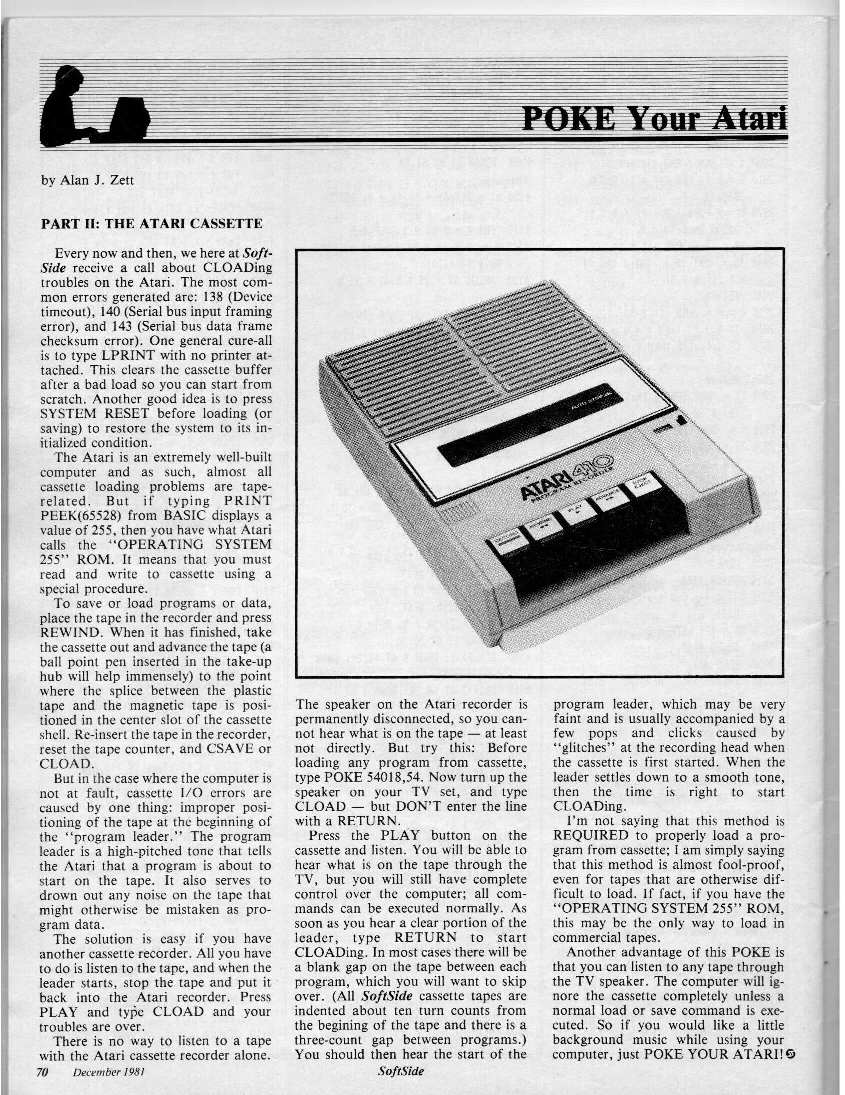
Every now and then, we here at SoftSide receive a call about CLOADing troubles on the Atari. The most common errors generated are: 138 (Device timeout), 140 (Serial bus input framing error), and 143 (Serial bus data frame checksum error). One general cure-all is to type LPRINT with no printer attached. This clears the cassette buffer after a bad load so you can start from scratch. Another good idea is to press SYSTEM RESET before loading (or saving) to restore the system to its initialized condition.
The Atari is an extremely well-built computer and as such, almost all cassette loading problems are tape-related. But if typing PRINT PEEK(65528) from BASIC displays a value of 255, then you have what Atari calls the "OPERATING SYSTEM 255" ROM. It means that you must read and write to cassette using a special procedure.
To save or load programs or data, place the tape in the recorder and press REWIND. When it has finished, take the cassette out and advance the tape (a ball point pen inserted in the take-up hub will help immensely) to the point where the splice between the plastic tape and the magnetic tape is positioned in the center slot of the cassette shell. Re-insert the tape in the recorder, reset the tape counter, and CSAVE or CLOAD.
But in the case where the computer is not at fault, cassette I/O errors are caused by one thing: improper positioning of the "program leader." The program leader is a high-pitched tone that tells the Atari that a program is about to start on the tape. It also serves to drown out any noise on the tape that might otherwise be mistaken as program data.
The solution is easy if you have another cassette recorder. All you have to do is listen to the tape, and when the leader starts, stop the tape and put it back into the Atari recorder. Press PLAY and type CLOAD and your troubles are over.
There is no way to listen to a tape with the Atari cassette recorder alone. The speaker on the Atari recorder is permanently disconnected, so you cannot hear what is on the tape -- at least not directly. But try this: Before loading any program from cassette, type POKE 54018,54. Now turn up the speaker on your TV set, and type CLOAD -- but DON'T enter the line with a RETURN.
Press the PLAY button on the cassette and listen. You will be able to hear what is on the tape through the TV, but you will still have complete control over the computer; all commands can be executed normally. As soon as you hear a clear portion of the leader, type RETURN to start CLOADing. In most cases there will be a blank gap on the tape between each program, which you will want to skip over. (All SoftSide cassette tapes are indented about ten turn counts from the beginning of the tape and there is a three-count gap between programs.) You should then hear the start of the program leader, which may be very faint and is usually accompanied by a few pops and clicks caused by "glitches" at the recording head when the cassette is first started. When the leader settles down to a smooth tone, then the time is right to start CLOADing.
I'm not saying that this method is REQUIRED to properly load a program from cassette; I am simply saying that this method is almost fool-proof, even for tapes that are otherwise difficult to load. If fact, if you have the "OPERATING SYSTEM 255" ROM, this may be the only way to load in commercial tapes.
Another advantage of this POKE is that you can listen to any tape through the TV speaker. The computer will ignore the cassette completely unless a normal load or save command is executed. So if you would like a little background music while using your computer, just POKE YOUR ATARI!
| 70 | December 1981 | SoftSide |
Scan by Michael Current, April 17, 2010